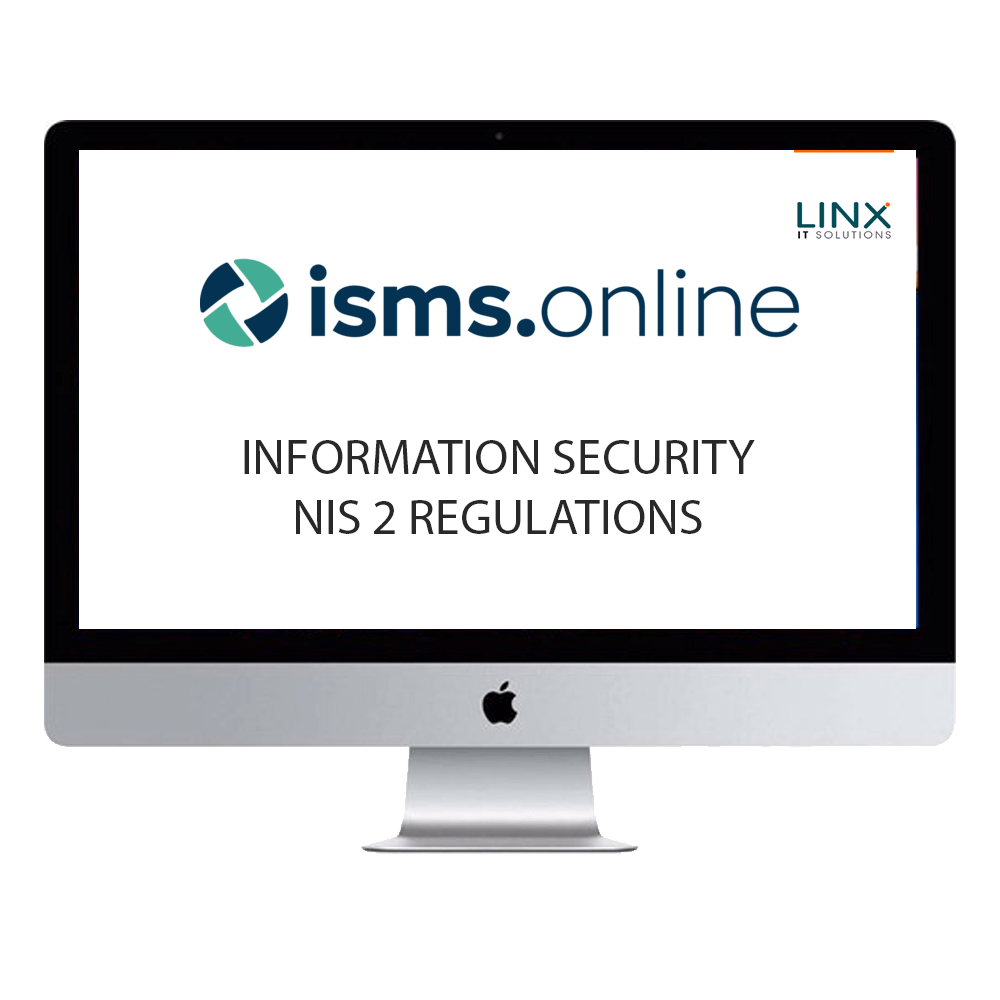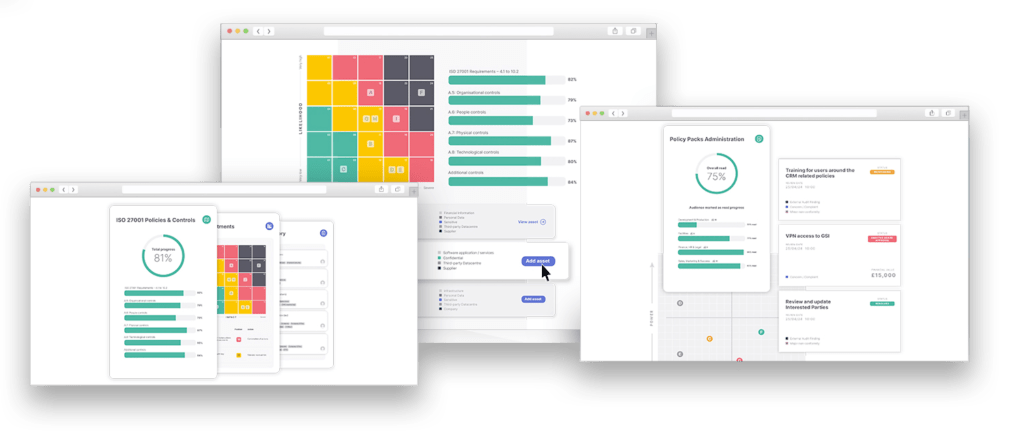Information Security: supporting businesses to organize their information security processes
The security of our society and economy is at stake due to various developments under increasing pressure. Think of pandemics and wars, but also on in the field of cyber threats, organizations are facing increasingly urgent challenges. Research by ISMS.online shows that 90% of organizations has had to deal with a cyber incident in the past year. And more than one on the three (36%) companies have experienced a data breach (source: State of Infosec report by ISMS.online). In view of the growing cyber threats, the European Union adopted the “Network and Cyber Threats” at the end of 2022
The Network Information Security directive’ (NIS2) obliges European member states to strengthen digital and economic resilience. The aim of the Directive is to limit the maximum amount of the digital (cyber) risks to the network and information systems of organizations.

Information Security embedded into your organization

In view of the NIS2 Directive, the Dutch government advises your organization to start now with the optimizing of your cybersecurity and ensuring the continuity of your business processes in the long term. This will protect your organization against existing cyber risks and ensure that your company‘s policies are organization is in line with the new legislation resulting from the NIS2 Directive. This is expected to be completed by the end of the year enter into force in 2024.
Linx IT Solutions is a long–term partner for customers in the field process optimization and digitalization for business processes. From that perspective, privacy and internet security have always been very important. Ensuring digital security and protecting privacy are an integral part of from the service provided to our customers. As a reseller, we offer you, based on our expertise in the field of Security and Privacy, a high–quality online platform for information security to: ISMS.online.
Risk analysis
Risk analysis is a multi-step process aimed at mitigating the impact of risks on business operations. It is used across different industries to protect all aspects of a business from potential threats. The process involves risk assessment, risk management, and risk communication.
Here are some types of risk analysis:
- Risk Benefit & Cost Benefit Analysis: This involves weighing the pros and cons of an action, including the potential success or failure and the estimated costs against the potential benefits
- Needs Assessment: This is a systematic process of identifying and evaluating organizational needs and gaps.
- Business Impact Analysis: This involves planning for operational disruptions caused by natural disasters and other external factors.
- Failure Mode and Effect Analysis: This is a method of anticipating potential failures in business processes and mitigating their impact.
- Root Cause Analysis: This focuses on identifying and eliminating root causes to solve problems.
Policies & Procedures
Creating effective policies and procedures for cybersecurity is crucial for safeguarding digital assets. Follow these steps to develop a comprehensive framework:
- Risk Assessment: Identify potential threats and vulnerabilities specific to your organization. Evaluate potential impacts on confidentiality, integrity, and availability of data.
- Legal and Regulatory Compliance: Understand and adhere to relevant laws and industry regulations to ensure that the policies align with legal requirements.
- Define Objectives: Clearly outline the goals of the cybersecurity policies. These may include data protection, access controls, incident response, and employee awareness.
- Involve Stakeholders: Engage key stakeholders, including IT personnel, legal experts, and management, to gather diverse perspectives and ensure comprehensive coverage.
- Policy Development: Draft clear, concise policies addressing identified risks. Include sections on acceptable use, access controls, data classification, encryption, and incident reporting.
- Employee Training: Develop training programs to educate employees on the policies and procedures. Ensure that staff understands their roles and responsibilities in maintaining cybersecurity.
- Implementation Plan: Define a phased approach for policy implementation. Clearly communicate changes, and provide necessary resources and support during the transition.
- Regular Review and Update: Regularly review and update policies to adapt to evolving threats and organizational changes. Periodic assessments ensure that the policies remain relevant and effective.
- Monitoring and Enforcement: Implement mechanisms for continuous monitoring of policy compliance. Establish consequences for non-compliance, creating a culture of accountability.
- Incident Response Plan Integration: Integrate the cybersecurity policies with an incident response plan, ensuring a coordinated approach to managing and mitigating security incidents.
By following these steps, organizations can develop and implement robust cybersecurity policies and procedures, fostering a secure digital environment and mitigating potential risks effectively. Regular reviews and updates are essential to staying ahead of emerging cyber threats.
Training & Awareness
Training and awareness sessions for Information Security are crucial for several reasons:
- Protect Sensitive Data: One of the primary reasons for conducting these sessions is to protect sensitive data1. Employees learn about the variety of security threats your organization faces daily.
- Regulatory Compliance: Having an information security awareness training program provides proof that the organization is in compliance with the law. This type of training is normally required for all employees.
- Reduce Human Error: Human error is a leading cause of breaches and attacks. Security awareness training educates employees on how to protect the company when using technology, reducing the chance of human error.
- Develop a Security-focused Culture: Regular training instills better habits and helps to develop a security-focused culture within the organization.
- Empower Employees: When employees feel confident about their interactions with data that must follow security protocols, they are less likely to cause an incident.
- Protect Assets: A security breach can be devastating to a company’s reputation and finances. Security awareness training is an investment that helps protect your assets.
- Prevent Downtime: Should a breach or incident occur, it takes considerable time to investigate and repair. Security awareness training helps prevent such disruptions.
In summary, these sessions are an essential tool for companies that want to effectively protect their data, reduce the number of human-related incidents, reduce the cost of the response, and ensure their employees understand how to responsibly handle client data and safely navigate being online.
Incident response plan
Creating an effective Incident Response Plan (IRP) involves several key steps to efficiently manage and mitigate cybersecurity incidents.
- Preparation: Identify and document critical assets, establish an incident response team, and define their roles and responsibilities. Develop communication strategies, including internal and external stakeholders.
- Identification: Implement monitoring systems to detect potential incidents promptly. Define what constitutes an incident and establish alert mechanisms.
- Containment: Once an incident is detected, isolate affected systems to prevent further damage. This may involve disconnecting from the network or implementing access controls.
- Eradication: Identify and remove the root cause of the incident. This step aims to eliminate the threat entirely and prevent future occurrences.
- Recovery: Begin restoring affected systems and data from backups. Ensure that the recovery process is methodical and verified for completeness.
- Lessons Learned: Conduct a thorough post-incident analysis. Evaluate the response effectiveness and identify areas for improvement in both technical and procedural aspects.
- Documentation and Reporting: Document all actions taken during the incident response process. Prepare reports for stakeholders, detailing the incident, response actions, and recommendations for future enhancements.
Regularly review and update the IRP to align with evolving cyber threats and organizational changes. Regular drills and training sessions also help ensure the effectiveness of the plan and the readiness of the incident response team.
Supervision & Enforcement
Supervision and enforcement in cybersecurity are critical for maintaining a secure digital environment. The process involves active monitoring, policy enforcement, and corrective actions to ensure compliance.
- Continuous Monitoring: Employ security tools to monitor network traffic, system logs, and user activities in real-time. This helps identify unusual patterns or potential threats promptly.
- Policy Implementation: Establish and enforce comprehensive security policies outlining acceptable use, access controls, and data protection measures. Regularly update these policies to address emerging threats.
- Incident Detection and Response: Implement automated systems to detect and respond to security incidents promptly. This involves setting up alerts and automated responses for suspicious activities.
- Access Control and Authentication: Utilize robust access controls and multi-factor authentication to ensure that only authorized individuals access sensitive information.
- Regular Audits and Assessments: Conduct periodic security audits and assessments to identify vulnerabilities and non-compliance issues. This helps in proactively addressing potential security gaps.
- User Training and Awareness: Educate users about security policies, threats, and safe online practices. Awareness programs enhance user understanding and reduce the likelihood of security breaches.
- Enforcement Measures: Implement consequences for policy violations, ensuring accountability. This may involve temporary access restrictions, additional training, or more severe penalties for repeat offenses.
- Regular Updates and Patch Management: Keep software, operating systems, and security tools up-to-date to address vulnerabilities. Regularly patching and updating systems is crucial for maintaining a secure environment.
By integrating these steps, organizations can establish a proactive cybersecurity approach, minimizing risks, ensuring compliance, and swiftly responding to potential threats. Regular reviews and adjustments to security protocols enhance the overall effectiveness of supervision and enforcement measures.
ISMS.online
Uncomplicated compliance. ISMS.online has everything you need to streamline your compliance management. Say hello to your new compliance toolkit.
Built for your business. ISMS.online is built with everything you need to succeed with ease, and it’s ready to use straight out of the box. With over 100 frameworks available we can help to quickly create and maintain the right management system for your business.
Your all in one place solution. ISMS.online supports over 100 of the most in-demand compliance frameworks including ISO 27001, ISO 27701, ISO 22301, NIS2, GDPR and many more.
The only compliance software you need. ISMS.online is a leading provider of compliance software. The solution can be used to manage information security, privacy, business continuity or as an integrated system for all your compliance needs.
Seeing is believing
We would like to show you what Linx IT Solutions can do for your business. We will answer your questions about the features of our solutions and support with examples from our practice. With a live demo, we can let you experience the power of our solutions. Our experts are happy to help you on your way to a more successful business.

